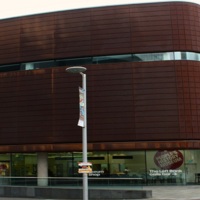
People's History Museum
The People's History Museum (PHM) is Britain’s national museum of democracy, telling the story of its development in Britain; past, present and future. It is located in Manchester, the world's first industrialised city and aims to ‘engage, inspire and inform diverse audiences by showing there have always been ideas worth fighting for’. Attracting over 100,000 visitors a year, with free entry, the museum outlines the political consciousness of the British population beginning with the Peterloo Massacre in 1819. The British transatlantic slave trade and the abolition movement feature in this discussion early on in Main Gallery One. In a small display, the interpretation discusses the role of slave-produced cotton in the rise of Manchester as an industrial powerhouse. It goes on to describe the important role that the people of Manchester had in supporting the abolition campaign. The focus is on the local experience. This is also illustrated with one of the exhibition’s key interpretive characters, William Cuffay, a mixed-race Chartist leader whose father was a former slave. In Main Gallery Two, the displays are brought closer to the present day, other issues explored include anti-racism and attitudes towards migration and multiculturalism. There is a clear link, although not explicitly expressed, in the interpretive text between these ideas and the lasting legacies of Britain's involvement in the slave trade.

Hetty, Esther and Me
Hetty, Esther and Me was an original drama researched, written and performed by Trafford Youth Service and 15 African Caribbean girls from Stretford High School. The play was performed at Quarry Bank Mill, a working Georgian cotton mill on the outskirts of Manchester, owned by the National Trust. The play centred on connections between cotton produced by slaves and child labour in English mills, and the wider social issues of slavery and poverty during the Industrial Revolution. The story was told through the relationship between a slave girl (Hetty), a young mill worker (Esther) and a group of young women living in present-day Trafford.
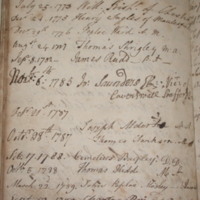
Exhibition on Thomas Clarkson at Manchester Cathedral
Manchester Cathedral held an exhibition on the abolitionist Thomas Clarkson in 2007. Clarkson was invited to preach a sermon at the Collegiate Church (which became Manchester Cathedral) in 1787, a sermon which had a profound impact on public opinion and support for anti-slavery societies in the city. Clarkson's name was recorded in the 'Book of Strange Preachers at the Collegiate Church, Manchester', on display at the exhibition.
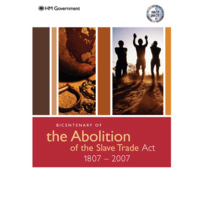
Bicentenary of the Abolition of the Slave Trade Act 1807-2007
The official publication from the British Government in response to the bicentenary included a message from Prime Minister Tony Blair. It set out the history of transatlantic slavery and resistance to it, and featured a calendar of upcoming events for 2007 relating to slavery and abolition. The publication also detailed contemporary efforts to end modern slavery. Later in 2007, 'The way forward: bicentenary of the abolition of the Slave Trade Act 1807-2007' reflected on some of the commemorative activity that had taken place in Bristol, Hull, Liverpool, London and Greater Manchester. With a foreword by the new Prime Minister, Gordon Brown, the theme of the publication was 'Reflecting on the past, looking to the future' and it linked efforts for the abolition of historical and contemporary slavery. The publication also looked to how to tackle inequality and poverty in the UK, Africa and the Caribbean.
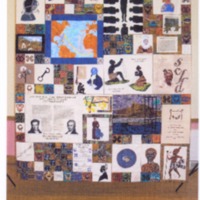
In Stitches
The In Stitches project was led by the African Families Foundation (TAFF) and brought together British, African and African-Caribbean women's quilting groups meeting in London, Liverpool, Bristol, Manchester and Birmingham. The In Stitches Quilt, designed by Janice Gunner, included 60 squares of embroidered images, texts and symbols, depicting historic figures, scenes and artefacts associated with the transatlantic slave trade and its abolition. The Quilt used several of the Adinkra symbols from Africa, originally printed on fabrics worn at funerals by the Akan peoples of Ghana. The accompanying work pack was designed to support learning about slavery based on the four themes of the Quilt: Capture, the Middle Passage, Life in the 'New World', and Proscription of Slavery. The Quilt was unveiled at City Hall in London, and then toured to the British Empire and Commonwealth Museum (Bristol), Central Library (Liverpool), Soho House (Birmingham), the International Quilt Festival (Birmingham) and Central Library (Manchester).
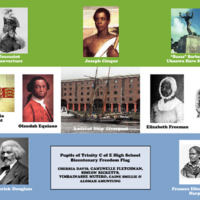
Bicentenary Freedom Flag
The Bicentenary Freedom Flag was displayed alongside an exhibition about Wartime Black History at Manchester Town Hall. The project was a collaboration between staff from Manchester City Council Corporate Services Black Staff Group and pupils of Trinity Church of England School in Manchester. The flag recognised the work, struggles and sacrifices of those who brought the slave trade to an end, and featured images of prominent individuals on the background of the Sierra Leone flag. Those featured on the flag included Toussaint L'Ouverture (General of the Haitian Uprising), the abolitionist Olaudah Equiano, the anti-slavery orator Frederick Douglass, the statue in Barbados of 'Bussa', the unknown slave, guide of the Underground Railroad Harriet Tubman, and Joseph Cinque, leader of the Amistad slave ship revolt. The accompanying exhibition included pupils' articles and creative writing. It also examined the history and role of the West India Regiments, British colonial infantry regiments largely recruited amongst freed slaves from North America and slaves purchased in the West Indies.
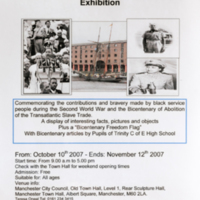
Wartime Black History and the Bicentenary
An exhibition by Manchester City Council held at Manchester Town Hall commemorated the contributions of Black service people during World War II. The exhibition also included the Bicentenary Freedom Flag, to mark commemorations of the Abolition Act of 1807. Alongside exploring the efforts of women, West Indian men, and African men in wartime, the exhibition also told the story of the 761st Tank Battalion of the US Army, known as the Black Panthers Tanker Battalion. Primarily made up of African-American soldiers, the squadron was said to be deployed as a public relations effort to maintain support for the war effort from the Black community.
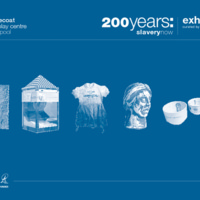
200 Years: Slavery Now
Bluecoat Display Centre is a contemporary craft and design gallery in Liverpool. The 200 Years: Slavery Now exhibition aimed to draw attention to modern slavery, both within the UK and in the wider international context. It brought together ten artists whose work reflected these concerns, and who were committed to highlighting the existence of slavery today through the creation of artefacts and the development of personal narratives. Materials used included ceramics, mixed media installations and textiles. Some of the themes covered included the exploitation of migrant workers, sex trafficking, 'sweat shop' mass production, and commemorating the Middle Passage and the workers of Manchester's cotton mills. The exhibition was curated by Professor Stephen Dixon, with the support of the Craft and Design Research Centre, MIRIAD, at Manchester Metropolitan University.
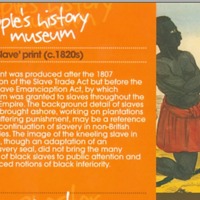
Revealing Histories: Remembering Slavery (People's History Museum)
Events at the People's History Museum in Manchester included a Revealing Histories trail, which highlighted museum objects with links to slavery, such as 'The Slave' print from the 1820s. A living history performance, 'How do you plead?', featured a representation of the Chartist leader William Cuffay, whose campaign for the right to vote saw him transported to Tasmania for treason.
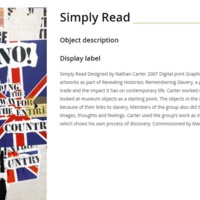
Revealing Histories: Remembering Slavery (Manchester Art Gallery)
As part of the Revealing Histories: Remembering Slavery project, Manchester Art Gallery highlighted items in its collection of fine art and decorative objects which revealed the wealth generated by the region's involvement in the transatlantic slave trade and the public's consumption of sugar, tea, coffee and tobacco. Additional special events included Tina Tamsho-Thomas performing poetry commissioned in response to the objects connected to sugar. In the exhibition 'Manchester Attitude', local community groups created a new display to express their thoughts about the legacy of Manchester's involvement in the transatlantic slave trade. Examples of these community-led artworks include 'Injustice' (with artists Colette Gilmartin and Tony Curry) and 'Simply Read' (with artist Nathan Carter), available to view on Manchester Art Gallery's website.
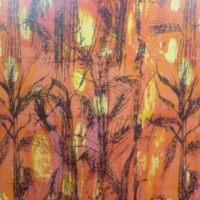
Trade and Empire: Remembering Slavery
The Whitworth Art Gallery was one of eight heritage bodies in the ‘Revealing Histories: Remembering Slavery’ partnership in Greater Manchester. The project set out to explore the history, impact and legacy of slavery on Britain through collections and community links in the North West.
'Trade and Empire: Remembering Slavery' explored the themes of trade and empire, commerce and collecting, and the impact of the experience of slavery and its legacy. Four invited artists and academics (SuAndi, Kevin Dalton-Johnson, Dr Emma Poulter and Dr Alan Rice) worked with Whitworth curators and learning staff to create the exhibition. It comprised of selections from the Whitworth's collections, contemporary works by Black artists, and objects on loan from Manchester Museum, John Rylands University Library Manchester, Bolton Museums and Archives Service and private collections. Areas of focus included a history of the Benin Bronzes, representations of Black people in British art, photographs of West Africa belonging to Tom Singleton Gardner, and printed textiles designed by Althea McNish. The exhibition was accompanied by a series of community engagement events.
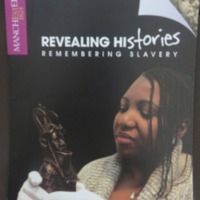
Revealing Histories: Remembering Slavery (The Manchester Museum)
The Manchester Museum was one of eight heritage bodies in the ‘Revealing Histories: Remembering Slavery’ partnership in Greater Manchester. The project set out to explore the history, impact and legacy of slavery on Britain through collections and community links in the North West.
The Manchester Museum examined the role of Victorian institutions in promoting the racist thinking that justified slavery; objects and images in the museum's collections were identified as having been used to support racist ideas. Events and workshops included a debate based on the question 'Are museums racist?', plus sessions on African dance traditions. 'This Accursed Thing' was a promenade performance around the museum, examining the transatlantic slave trade through the eyes of those involved - abolitionists and traders, slavers and slaves - and looking at ways in which individuals attempted to dispel racist myths. The 'Myths about Race' exhibition was the culmination of Manchester Museum's participation in the Revealing Histories project.
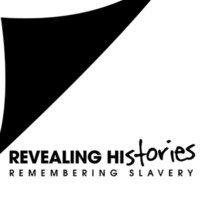
Revealing Histories: Remembering Slavery
The Revealing Histories: Remembering Slavery project sought to uncover the North West's involvement in the slave trade (and the consequent social and economic effects of this involvement) and the region's contribution to the abolition of the transatlantic slave trade and colonial slavery. Eight museums and galleries across Greater Manchester collaborated to commemorate the lasting legacies of the transatlantic slave trade. The participating venues were: Bolton Museum and Archive Service; Gallery Oldham; Manchester Art Gallery; The Manchester Museum; Museum of Science and Industry; People's History Museum; Touchstones Rochdale; and Whitworth Art Gallery. A collaborative website and a programme of exhibitions, trails, performances, films and events took a new look at the collections of these museums and galleries and the buildings in which they are housed, revealing hidden histories of the region's involvement in the slave trade. The project also examined slavery's contemporary legacy and relevance.
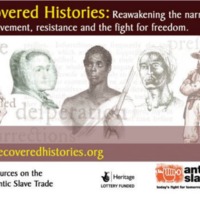
Recovered Histories
In the Recovered Histories online resource, Anti-Slavery International digitised and made accessible for the first time a collection of over 800 pamphlets dating from the 18th and 19th centuries relating to the transatlantic slave trade. The resource captured the narratives of the enslaved, the enslavers, slave ship surgeons, abolitionists, parliamentarians, clergy, planters and rebels. An accompanying touring historical exhibition and an education pack featured testimonies and pictures from Africans subjected to slavery, those participating in the enslavement and those who fought against it. An outreach and resources programme included a series of free regional seminars in April and May 2008, which encouraged dialogue about the transatlantic slave trade and its legacies by bringing together a wide range of groups and organisations who worked on these issues. The workshops were held in Bristol, Edinburgh, Leeds, London and Manchester. A series of short stories were published, inspired by the Recovered Histories resource.
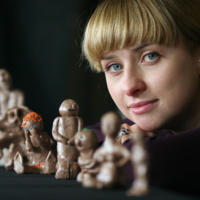
Revealing Histories: Remembering Slavery (Museum of Science and Industry)
The Museum of Science and Industry (MOSI) was one of eight heritage bodies in the ‘Revealing Histories: Remembering Slavery’ partnership in Greater Manchester. The project set out to explore the history, impact and legacy of slavery on Britain through collections and community links in the North West.
An exhibition and trail at MOSI explored the connections between Manchester’s economic success from the late eighteenth century onwards and its international trade, particularly the cotton trade with the USA, with its associated links to the transatlantic slave trade. Items identified in the collection included an American Civil War patriotic envelope from 1861, which satirised Britain's willingness to ignore the plight of American slaves. Other events included the creation of a series of terracotta figures depicting slaves on a slave ship by artist Annette Cobley. Workshop sessions to accompany this artwork were based on the theme of silence surrounding slavery.